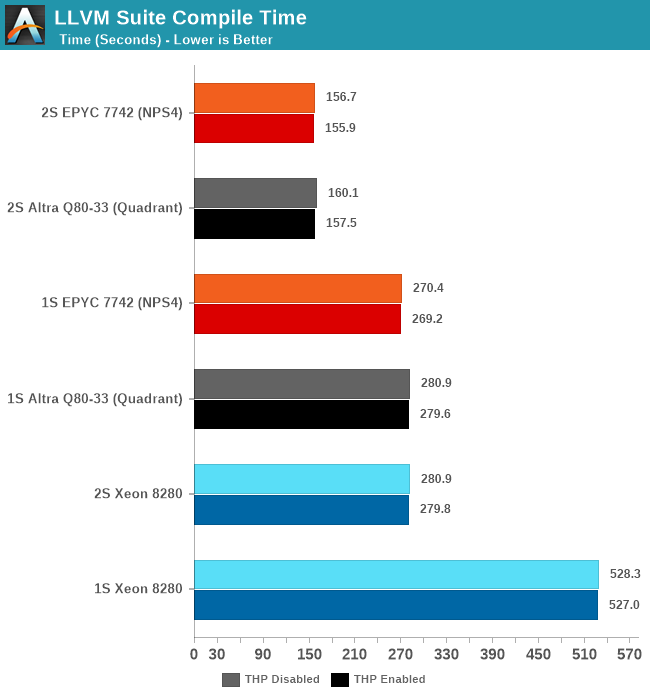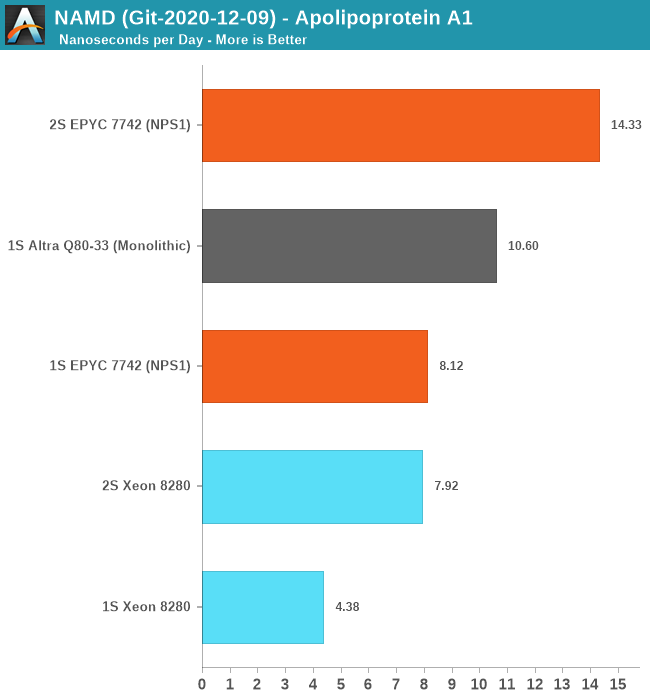The Ampere Altra Review: 2x 80 Cores Arm Server Performance Monster
by Andrei Frumusanu on December 18, 2020 6:00 AM EST- Posted in
- Servers
- Neoverse N1
- Ampere
- Altra
Compiling LLVM, NAMD Performance
As we’re trying to rebuild our server test suite piece by piece – and there’s still a lot of work go ahead to get a good representative “real world” set of workloads, one more highly desired benchmark amongst readers was a more realistic compilation suite. Chrome and LLVM codebases being the most requested, I landed on LLVM as it’s fairly easy to set up and straightforward.
git clone https://github.com/llvm/llvm-project.gitcd llvm-projectgit checkout release/11.xmkdir ./buildcd ..mkdir llvm-project-tmpfssudo mount -t tmpfs -o size=10G,mode=1777 tmpfs ./llvm-project-tmpfscp -r llvm-project/* llvm-project-tmpfscd ./llvm-project-tmpfs/buildcmake -G Ninja \ -DLLVM_ENABLE_PROJECTS="clang;libcxx;libcxxabi;lldb;compiler-rt;lld" \ -DCMAKE_BUILD_TYPE=Release ../llvmtime cmake --build .We’re using the LLVM 11.0.0 release as the build target version, and we’re compiling Clang, libc++abi, LLDB, Compiler-RT and LLD using GCC 10.2 (self-compiled). To avoid any concerns about I/O we’re building things on a ramdisk – on a 4KB page system 5GB should be sufficient but on the Altra’s 64KB system it used up to 9.5GB, including the source directory. We’re measuring the actual build time and don’t include the configuration phase as usually in the real world that doesn’t happen repeatedly.

The Altra Q80-33 here performs admirably and pretty much matches the AMD EPYC 7742 both in 1S and 2S configurations. There isn’t exact perfect scaling between sockets because this being a actual build process, it also includes linking phases which are mostly single-threaded performance bound.
Generally, it’s interesting to see that the Altra here fares better than in the SPEC 502.gcc_r MT test – pointing out that real codebases might not be quite as demanding as the 502 reference source files, including a more diverse number of smaller files and objects that are being compiled concurrently.
NAMD
Another rather popular benchmark tool that we’ve actually seen being used by vendors such as AMD in their marketing materials when showcasing HPC performance for their server chips is NAMD. This actually quite an interesting adventure in terms of compiling the tool for AArch64 as essentially there little to no proper support for it. I’ve used the latest source drop, essentially the 2.15alpha / 3.0alpha tree, and compiled it from scratch on GCC 10.2 using the platform’s respective -march and -mtune targets.
For the Xeon 8280 – I did not use the AVX512 back-end for practical reasons: The code which introduces an AVX512 algorithm and was contributed by Intel engineers to NAMD has no portability to compilers other than ICC. Beyond this being a code-path that has no relation with the “normal” CPU algorithm – the reliance on ICC is something that definitely made me raise my eyebrows. It’s a whole other discussion topic on having a benchmark with real-world performance and the balance of having an actual fair and balanced apple to apples comparison. It’s something to revisit in the future as I invest more time into looking the code and see if I can port it to GCC or LLVM.

For the single-socket numbers – we’re using the multicore variant of the tool which has predictable scaling across a single NUMA node. Here, the Ampere Altra Q80-33 performed amazingly well and managed to outperform the AMD EPYC 7742 by 30% - signifying this is mostly a compute-bound workload that scales well with actual cores.
For the 2S figures, using the multicore binaries results in undeterministic performance – the Altra here regressed to 2ns/day and the EPYC system also crashed down to 4ns/day – oddly enough the Xeon system had absolutely no issue in running this properly as it had excellent performance scaling and actually outperforms the MPI version. The 2S EPYC scales well with the MPI version of the benchmark, as expected.
Unfortunately, I wasn’t able to compile an MPI version of NAMD for AArch64 as the codebase kept running into issues and it had no properly maintained build target for this. In general, I felt like I was amongst the first people to ever attempt this, even though there are some resources to attempt to help out on this.
I also tried running Blender on the Altra system but that ended up with so many headaches I had to abandon the idea – on CentOS there were only some really old build packages available in the repository. Building Blender from source on AArch64 with all of its dependencies ends up in a plethora of software packages which simply assume you’re running on x86 and rely on basic SSE intrinsics – easy enough to fix that in the makefiles, but then I hit some other compilation errors after which I lost my patience. Fedora Linux seemed to be the only distribution offering an up-to-date build package for Blender – but I stopped short of reinstalling the OS just to benchmark Blender.
So, while AArch64 has made great strides in the past few years – and the software situation might be quite good for server workloads, it’s not all rosy and we’re still have ways to go before it can be considered a first-class citizen in the software ecosystem. Hopefully Apple’s introduction of Apple Silicon Macs will accelerate the Arm software ecosystem.










148 Comments
View All Comments
mode_13h - Thursday, December 31, 2020 - link
Isn't Blender included in SPECfp2017 as 526.blender_r? Or is that something different?Teckk - Friday, December 18, 2020 - link
Whoever decided on naming these products — fantastic job. Simple, clear and effective.Maybe you can offer some free advice to Intel and Sony.
Calin - Friday, December 18, 2020 - link
The answer to the question of "how powerful it is" is clear - more than good enough.The real question in fact is:
"How much can they produce?"
AMD has the crown in x86 processor performance, but this doesn't really matter very much as long as they can build enough processors only for a part of the market.
jwittich - Friday, December 18, 2020 - link
How many do you need? :)Bigos - Friday, December 18, 2020 - link
64kB pages might significantly enhance performance on workload with large memory sets, as the TLB will be up to 16x less used. On the other hand, memory usage of the Linux file system cache will also increase a lot.Would you be able to test the effect of 64kB vs 4kB page size on at least some workloads?
Andrei Frumusanu - Friday, December 18, 2020 - link
It's something that I wanted to test but it requires a OS reinstall / kernel recompile - I didn't want to get into that rabbit hole of a time sink as already spent a lot of time verifying a lot of data across the three platforms over a few weeks already.arnd - Friday, December 18, 2020 - link
I'd love to see that as well. For workloads that use transparent huge pages, there should not be much difference since both would use 2MB huge pages (512*4KB or 32*64KB), plus one or more even larger page sizes, but it needs to be measured to beThe downsides of 64KB requiring larger disk I/O and more RAM are often harder to quantify, as most benchmarks try to avoid the interesting cases.
I've tried benchmarking kernel compiles on Graviton2 both ways and found 64kB pages to be a few percent faster when there is enough RAM, but forcing the system to swap by limiting the total RAM made the 64kB kernel easily 10x to 1000x slower than the 4kB one, depending on the how the available memory lined up with the working set.
abufrejoval - Friday, December 18, 2020 - link
Thank you for the incredible amount of information and the work you put into this: Anandtech's best!Yet I wonder who would deploy this and where. The purchasing price of the CPU would seem to become a rather miniscule part of the total system cost, especially once you go into big RAM territory. And I wonder if it's not similar with the energy budget: I see my larger systems requiring more $ and Watts on RAM than on the CPUs. Are they doing, can they do anything there to reduce DRAM energy consumption vs. Intel/AMD?
The cost of the ecosystem change to ARM may be less relevant once you have the scale to pay for it, but where exactly would those scale benefits come from? And what scales are we talking about? Would you need 100k or 1m servers to break even?
And what sort of system load would you have to reach/maintain to have significant energy advantages vs. x86 iron?
Do they support special tricks like powering down quadrants and RAM banks for load management, do they enable quick standby/actvation modes so that servers can be take off and on for load management?
And how long would the benefits last? AMD has demonstrated rather well, that the ability to execute over at least three generations of hardware are required to shift attention even from the big guys and they have still all the scaling benefits the x86 installed base provides.
These guys are on a 2nd generation product, promise 3rd but essentially this would seem to have the same level of confidence as the 1st EPIC.
askar - Friday, December 18, 2020 - link
Would you mind testing ML performance, i.e. python's SKLearn library classes that can be multithreaded (random forest for example)?mode_13h - Sunday, December 20, 2020 - link
MLPerf?